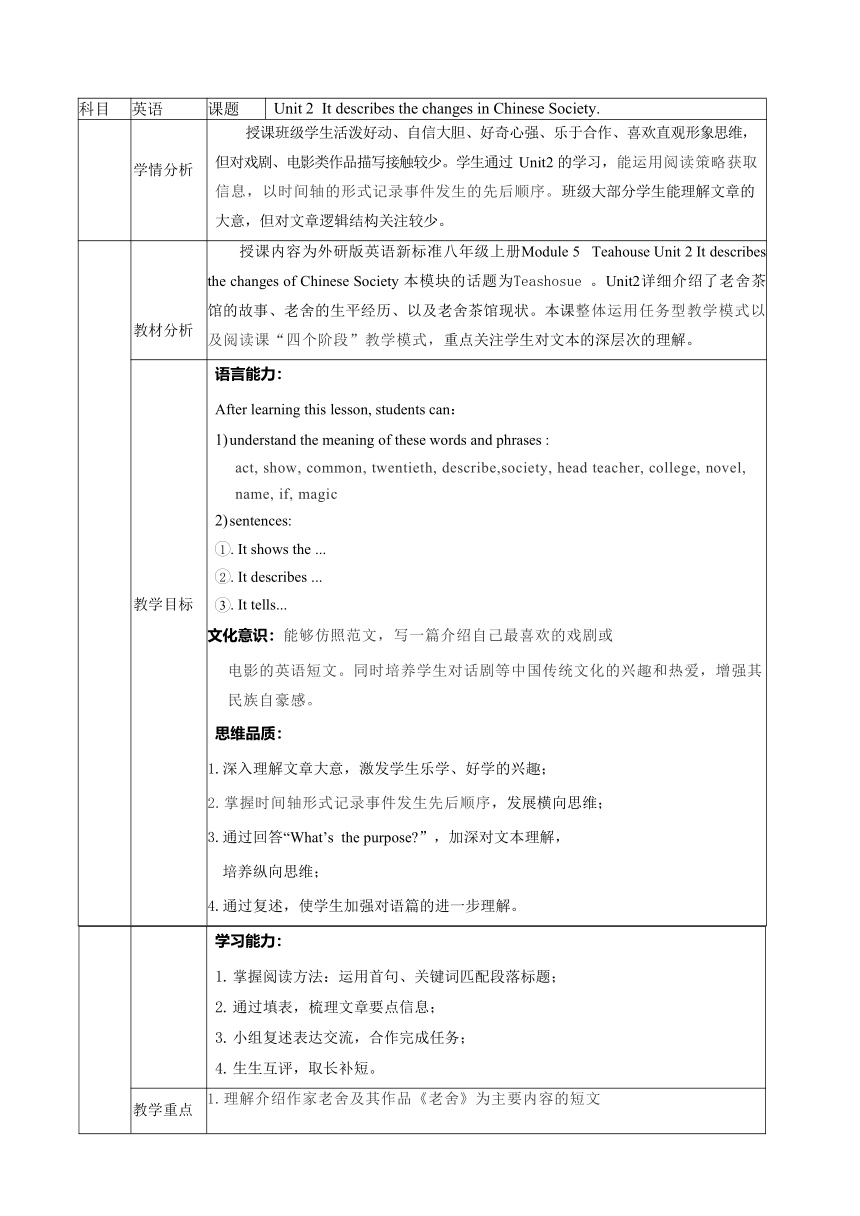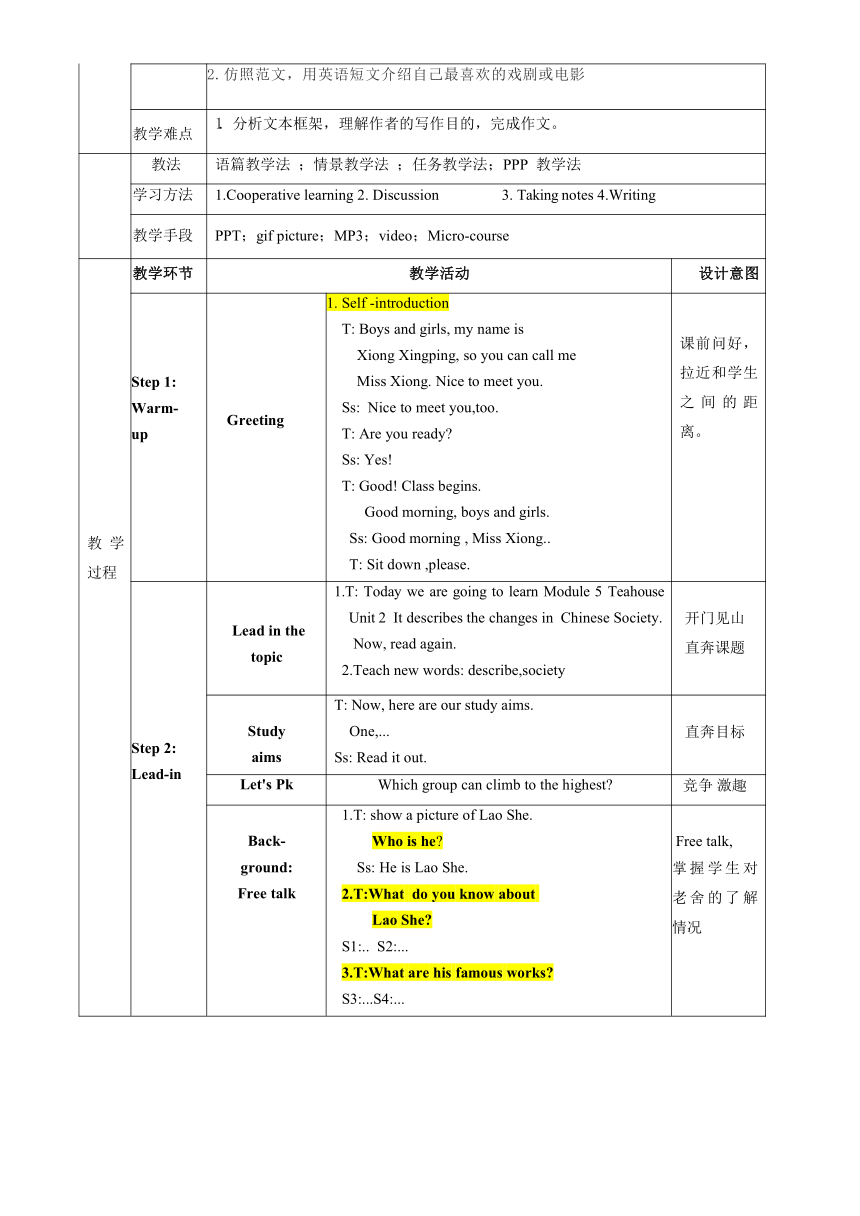Module 5 Lao She Unit 2 It describes the changes in Chinese Society优课教案
文档属性
| 名称 | Module 5 Lao She Unit 2 It describes the changes in Chinese Society优课教案 |  | |
| 格式 | docx | ||
| 文件大小 | 2.4MB | ||
| 资源类型 | 教案 | ||
| 版本资源 | 外研版 | ||
| 科目 | 英语 | ||
| 更新时间 | 2021-10-11 21:47:02 | ||
图片预览


文档简介
科目 英语 课题 Unit 2 It describes the changes in Chinese Society.
学情分析 授课班级学生活泼好动、自信大胆、好奇心强、乐于合作、喜欢直观形象思维,但对戏剧、电影类作品描写接触较少。学生通过 Unit2 的学习,能运用阅读策略获取信息,以时间轴的形式记录事件发生的先后顺序。班级大部分学生能理解文章的大意,但对文章逻辑结构关注较少。
教材分析 授课内容为外研版英语新标准八年级上册Module 5 Teahouse Unit 2 It describes the changes of Chinese Society 本模块的话题为Teashosue 。Unit2详细介绍了老舍茶馆的故事、老舍的生平经历、以及老舍茶馆现状。本课整体运用任务型教学模式以及阅读课“四个阶段”教学模式,重点关注学生对文本的深层次的理解。
教学目标 语言能力: After learning this lesson, students can: understand the meaning of these words and phrases : act, show, common, twentieth, describe,society, head teacher, college, novel, name, if, magic sentences: It shows the ... It describes ... It tells... 文化意识:能够仿照范文,写一篇介绍自己最喜欢的戏剧或 电影的英语短文。同时培养学生对话剧等中国传统文化的兴趣和热爱,增强其民族自豪感。 思维品质: 1.深入理解文章大意,激发学生乐学、好学的兴趣; 2.掌握时间轴形式记录事件发生先后顺序,发展横向思维; 3.通过回答“What’s the purpose ”,加深对文本理解, 培养纵向思维; 4.通过复述,使学生加强对语篇的进一步理解。
学习能力: 掌握阅读方法:运用首句、关键词匹配段落标题; 通过填表,梳理文章要点信息; 小组复述表达交流,合作完成任务; 生生互评,取长补短。
教学重点 1.理解介绍作家老舍及其作品《老舍》为主要内容的短文 2.仿照范文,用英语短文介绍自己最喜欢的戏剧或电影
教学难点 分析文本框架,理解作者的写作目的,完成作文。
教法 语篇教学法 ;情景教学法 ;任务教学法;PPP 教学法
学习方法 1.Cooperative learning 2. Discussion 3. Taking notes 4.Writing
教学手段 PPT;gif picture;MP3;video;Micro-course
教学过程 教学环节 教学活动 设计意图
Step 1: Warm-up Greeting Self -introduction T: Boys and girls, my name is Xiong Xingping, so you can call me Miss Xiong. Nice to meet you. Ss: Nice to meet you,too. T: Are you ready Ss: Yes! T: Good! Class begins. Good morning, boys and girls. Ss: Good morning , Miss Xiong.. T: Sit down ,please. 课前问好,拉近和学生之间的距离。
Step 2: Lead-in Lead in the topic 1.T: Today we are going to learn Module 5 Teahouse Unit 2 It describes the changes in Chinese Society. Now, read again. 2.Teach new words: describe,society 开门见山 直奔课题
Study aims T: Now, here are our study aims. One,... Ss: Read it out. 直奔目标
Let's Pk Which group can climb to the highest 竞争 激趣
Back- ground: Free talk 1.T: show a picture of Lao She. Who is he Ss: He is Lao She. 2.T:What do you know about Lao She S1:.. S2:... 3.T:What are his famous works S3:...S4:... Free talk, 掌握学生对老舍的了解情况
Step 3: Reading Pre-reading Word -map T: Show a picture of Lao She Lao She is a great writer. What did he wrote Ss: He wrote many novels. T: One of his most famous works is... Ss: Lao She Teahouse. T: What does Teahouse describe Ss: It describes the changes in... T:What does it show Ss: It shows... 1.Word-map 形式,形象生动,简单易懂。 2.导图中学习新词和句型,为学生扫清阅读障碍。
Skimming 1.T: Read the passage and match the headings with the paragraphs. There are 3 headings. 2 minutes for you! 2.T: Have you finished Who likes to tell your answers Come here, match! 3.T: How to get the main idea Can you underline the sentences T:Can you find the good ways to get the main ideas 4.T: Here is my tip. Ss read aloud. 1.快速阅读文,理解段落 大意找标题,培养学生获取主旨的能力,并学习铺垫。 2.PK 正式开始,激发兴趣 3.传授阅读技巧,提高阅读能力。
Careful reading Para 1 T: Now, read Para 1 again, finish the table. 3 minutes for you! 2.T: Are you OK Let’s check it. Any volunteers T: Great ./ Excellent . / Wonderful! Well done. / Good job!/ Pretty good ! 细读第一段,获取具体信息,知识点和课文理解在分段学习得以突破
Careful reading Para 2 1.Complete the timeline with key words. 3 minitues for you. 2.Work in pairs Retell the information about Lao She. Question: Why was Lao She named "the People's Artist" 细读第二段,填表,同桌合作复述课文,使学生加深对课文内容理解
Careful reading Para 3 T: Read Para 3 ,tell true of False. 3 minutes for you. T: Are you OK Let’s play a game. Two students come here, check True or False. T: Who is the winner Congratulations! (举起生的手) 1.细读第三段,判断正误,提高阅读能力。 2.游戏激趣,提高应变能力。
Step 4 Work in groups: Discuss 框架结构 T: Work in groups of four. Discuss : What's the purpose(目的) of the passage 2 minutes for you! S1:...S2:...S3:... T : My idea is.... Maybe you can find part of purpose according to Para 3 深挖作者 写作意图, 加强文本 理解
Step 5 同步板书 板书分析文章结构,形成思维导图,引导学生发现文章内容间联系,进一步了解作者写作意图,加深学生对 理 解 认知。
Step 6 写作 快速完成写作,将所学应用于实践。展示作文,学生自主打分、点评优点,树立效仿学习的榜样。
Step 7 情感升华 T: Would you like to visit the Lao She Teahouse Why T: At Lao She Teahouse, we can share our traditional culture. I think the Teahouse is a window of Chinese culture. Right T: Now, let’s learn more about Chinese Culture. Enjoy a video. T: We can see many kinds of culture. I’d like to say, we should be proud of Chinese! So, stand up, read aloud! Love our motherland,Love our traditional culture and pass it on. 情感升华,深挖作者写作意图,培养学生对话剧等中国传统文化的兴趣和热爱,增强其民族自豪感。
Step 8 课后作业 1. Remember the words and phrases learned today . 2.Tell people around you about your favourite plays or films 为写作课收集信息并与情感升华相呼应
反思 做得好的: 精心设计,循序渐进,进行学法指导渗透; 整体运用任务型教学模式以及阅读课“四个阶段”教学模式,重点关注到了学生对文本的深层次的理解。 3.提升学生思维品质: (1)追问,通过回答“What’s the purpose ”,加深对文本理解, 培养纵向思维; 通过复述,使学生加强对语篇的理解。 4.培养学生的阅读、写作能力将所学应用于实践。展示作文,学生自主打分、点评优点,树立效仿学习榜样。 不足之处: 1.关注学生个体不到位 2.激励性语言还可以再丰富些 3.时间掌控有待提高
学情分析 授课班级学生活泼好动、自信大胆、好奇心强、乐于合作、喜欢直观形象思维,但对戏剧、电影类作品描写接触较少。学生通过 Unit2 的学习,能运用阅读策略获取信息,以时间轴的形式记录事件发生的先后顺序。班级大部分学生能理解文章的大意,但对文章逻辑结构关注较少。
教材分析 授课内容为外研版英语新标准八年级上册Module 5 Teahouse Unit 2 It describes the changes of Chinese Society 本模块的话题为Teashosue 。Unit2详细介绍了老舍茶馆的故事、老舍的生平经历、以及老舍茶馆现状。本课整体运用任务型教学模式以及阅读课“四个阶段”教学模式,重点关注学生对文本的深层次的理解。
教学目标 语言能力: After learning this lesson, students can: understand the meaning of these words and phrases : act, show, common, twentieth, describe,society, head teacher, college, novel, name, if, magic sentences: It shows the ... It describes ... It tells... 文化意识:能够仿照范文,写一篇介绍自己最喜欢的戏剧或 电影的英语短文。同时培养学生对话剧等中国传统文化的兴趣和热爱,增强其民族自豪感。 思维品质: 1.深入理解文章大意,激发学生乐学、好学的兴趣; 2.掌握时间轴形式记录事件发生先后顺序,发展横向思维; 3.通过回答“What’s the purpose ”,加深对文本理解, 培养纵向思维; 4.通过复述,使学生加强对语篇的进一步理解。
学习能力: 掌握阅读方法:运用首句、关键词匹配段落标题; 通过填表,梳理文章要点信息; 小组复述表达交流,合作完成任务; 生生互评,取长补短。
教学重点 1.理解介绍作家老舍及其作品《老舍》为主要内容的短文 2.仿照范文,用英语短文介绍自己最喜欢的戏剧或电影
教学难点 分析文本框架,理解作者的写作目的,完成作文。
教法 语篇教学法 ;情景教学法 ;任务教学法;PPP 教学法
学习方法 1.Cooperative learning 2. Discussion 3. Taking notes 4.Writing
教学手段 PPT;gif picture;MP3;video;Micro-course
教学过程 教学环节 教学活动 设计意图
Step 1: Warm-up Greeting Self -introduction T: Boys and girls, my name is Xiong Xingping, so you can call me Miss Xiong. Nice to meet you. Ss: Nice to meet you,too. T: Are you ready Ss: Yes! T: Good! Class begins. Good morning, boys and girls. Ss: Good morning , Miss Xiong.. T: Sit down ,please. 课前问好,拉近和学生之间的距离。
Step 2: Lead-in Lead in the topic 1.T: Today we are going to learn Module 5 Teahouse Unit 2 It describes the changes in Chinese Society. Now, read again. 2.Teach new words: describe,society 开门见山 直奔课题
Study aims T: Now, here are our study aims. One,... Ss: Read it out. 直奔目标
Let's Pk Which group can climb to the highest 竞争 激趣
Back- ground: Free talk 1.T: show a picture of Lao She. Who is he Ss: He is Lao She. 2.T:What do you know about Lao She S1:.. S2:... 3.T:What are his famous works S3:...S4:... Free talk, 掌握学生对老舍的了解情况
Step 3: Reading Pre-reading Word -map T: Show a picture of Lao She Lao She is a great writer. What did he wrote Ss: He wrote many novels. T: One of his most famous works is... Ss: Lao She Teahouse. T: What does Teahouse describe Ss: It describes the changes in... T:What does it show Ss: It shows... 1.Word-map 形式,形象生动,简单易懂。 2.导图中学习新词和句型,为学生扫清阅读障碍。
Skimming 1.T: Read the passage and match the headings with the paragraphs. There are 3 headings. 2 minutes for you! 2.T: Have you finished Who likes to tell your answers Come here, match! 3.T: How to get the main idea Can you underline the sentences T:Can you find the good ways to get the main ideas 4.T: Here is my tip. Ss read aloud. 1.快速阅读文,理解段落 大意找标题,培养学生获取主旨的能力,并学习铺垫。 2.PK 正式开始,激发兴趣 3.传授阅读技巧,提高阅读能力。
Careful reading Para 1 T: Now, read Para 1 again, finish the table. 3 minutes for you! 2.T: Are you OK Let’s check it. Any volunteers T: Great ./ Excellent . / Wonderful! Well done. / Good job!/ Pretty good ! 细读第一段,获取具体信息,知识点和课文理解在分段学习得以突破
Careful reading Para 2 1.Complete the timeline with key words. 3 minitues for you. 2.Work in pairs Retell the information about Lao She. Question: Why was Lao She named "the People's Artist" 细读第二段,填表,同桌合作复述课文,使学生加深对课文内容理解
Careful reading Para 3 T: Read Para 3 ,tell true of False. 3 minutes for you. T: Are you OK Let’s play a game. Two students come here, check True or False. T: Who is the winner Congratulations! (举起生的手) 1.细读第三段,判断正误,提高阅读能力。 2.游戏激趣,提高应变能力。
Step 4 Work in groups: Discuss 框架结构 T: Work in groups of four. Discuss : What's the purpose(目的) of the passage 2 minutes for you! S1:...S2:...S3:... T : My idea is.... Maybe you can find part of purpose according to Para 3 深挖作者 写作意图, 加强文本 理解
Step 5 同步板书 板书分析文章结构,形成思维导图,引导学生发现文章内容间联系,进一步了解作者写作意图,加深学生对 理 解 认知。
Step 6 写作 快速完成写作,将所学应用于实践。展示作文,学生自主打分、点评优点,树立效仿学习的榜样。
Step 7 情感升华 T: Would you like to visit the Lao She Teahouse Why T: At Lao She Teahouse, we can share our traditional culture. I think the Teahouse is a window of Chinese culture. Right T: Now, let’s learn more about Chinese Culture. Enjoy a video. T: We can see many kinds of culture. I’d like to say, we should be proud of Chinese! So, stand up, read aloud! Love our motherland,Love our traditional culture and pass it on. 情感升华,深挖作者写作意图,培养学生对话剧等中国传统文化的兴趣和热爱,增强其民族自豪感。
Step 8 课后作业 1. Remember the words and phrases learned today . 2.Tell people around you about your favourite plays or films 为写作课收集信息并与情感升华相呼应
反思 做得好的: 精心设计,循序渐进,进行学法指导渗透; 整体运用任务型教学模式以及阅读课“四个阶段”教学模式,重点关注到了学生对文本的深层次的理解。 3.提升学生思维品质: (1)追问,通过回答“What’s the purpose ”,加深对文本理解, 培养纵向思维; 通过复述,使学生加强对语篇的理解。 4.培养学生的阅读、写作能力将所学应用于实践。展示作文,学生自主打分、点评优点,树立效仿学习榜样。 不足之处: 1.关注学生个体不到位 2.激励性语言还可以再丰富些 3.时间掌控有待提高
同课章节目录
- Module 1 How to learn English
- Unit 1 Let's try to speak English as much as possi
- Unit 2 You should smile at her.
- Unit 3 Language in use .
- Module 2 My home town and my country
- Unit 1 It's taller than many other buildings.
- Unit 2 Cambridge is a beautiful city in the east o
- Unit 3 Language in use .
- Module 3 Sports.
- Unit 1 Nothing is more exciting than playing tenni
- Unit 2 This year we training more carefully.
- Unit 3 Language in use .
- Module 4 Planes, ships and trains .
- Unit 1 He lives the farthest from school.
- Unit 2 What is the best way to travel.
- Unit 3 Language in use .
- Module 5 Lao She Teahouse.
- Unit 1 I wanted to see the Beijing Opera.
- Unit 2 It descibes the changes in Chinese society.
- Unit 3 Language in use .
- Module 6 Animals in danger.
- Unit 1 It allows people to get closer to them .
- Unit 2 The WWF is working hard to save them all.
- Unit 3 Language in use .
- Revision module A
- Module 7 A famous story
- Unit 1 Alice was sitting with her sister by the ri
- Unit 2 She was thinking about her cat.
- Unit 3 Language in use .
- Module 8 Accidents
- Unit 1 While the car were changing to red, a car s
- Unit 2 I was trying to pick it up when it bite me
- Unit 3 Language in use .
- Module 9 Population
- Unit 1 The population of China is about 1.37 billi
- Unit 2 Arnwick was a city with 200,000 people.
- Unit 3 Language in use .
- Module 10 The weathe
- Unit 1 It might snow.
- Unit 2 The weather is fine all year round.
- Unit 3 Language in use .
- Module 11 Way of life
- Unit 1 In China ,we open a gift later.
- Unit 2 In England, you usually drink tea with milk
- Unit 3 Language in use .
- Module 12 Help
- Unit 1 What should we do before help arrives?
- Unit 2 Stay away from windows and heavy furniture.
- Unit 3 Language in use .
- Revision module B
